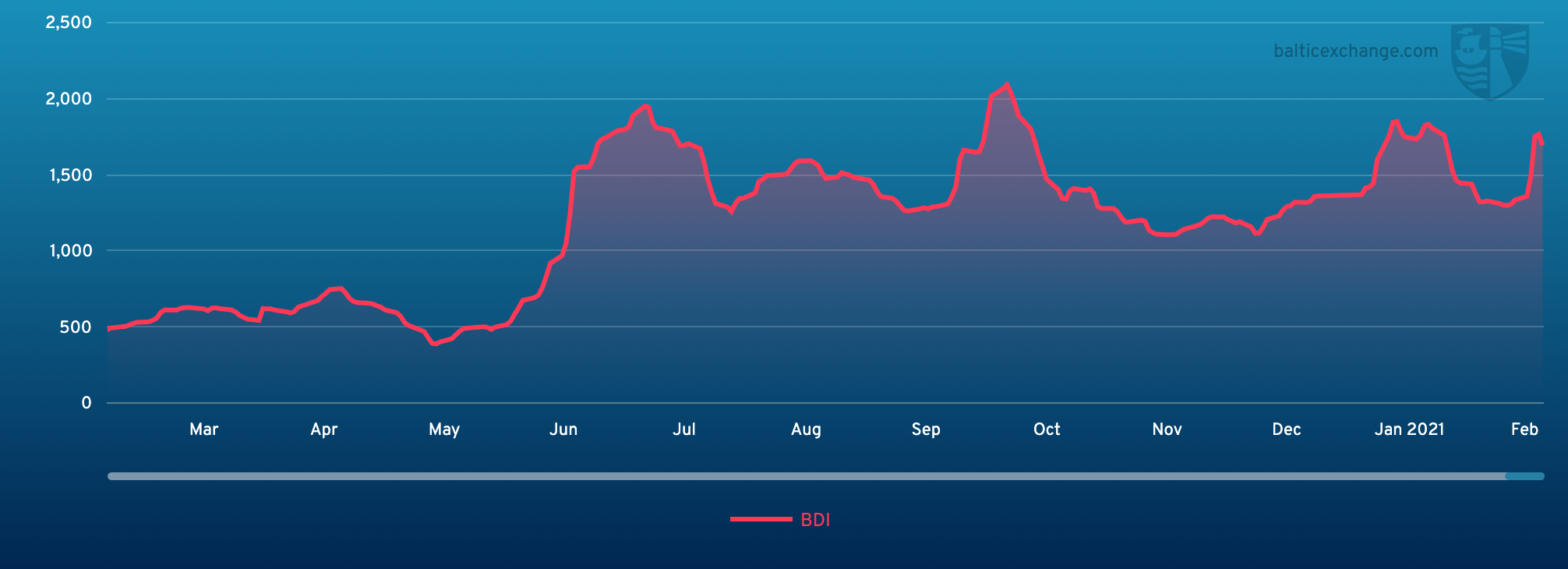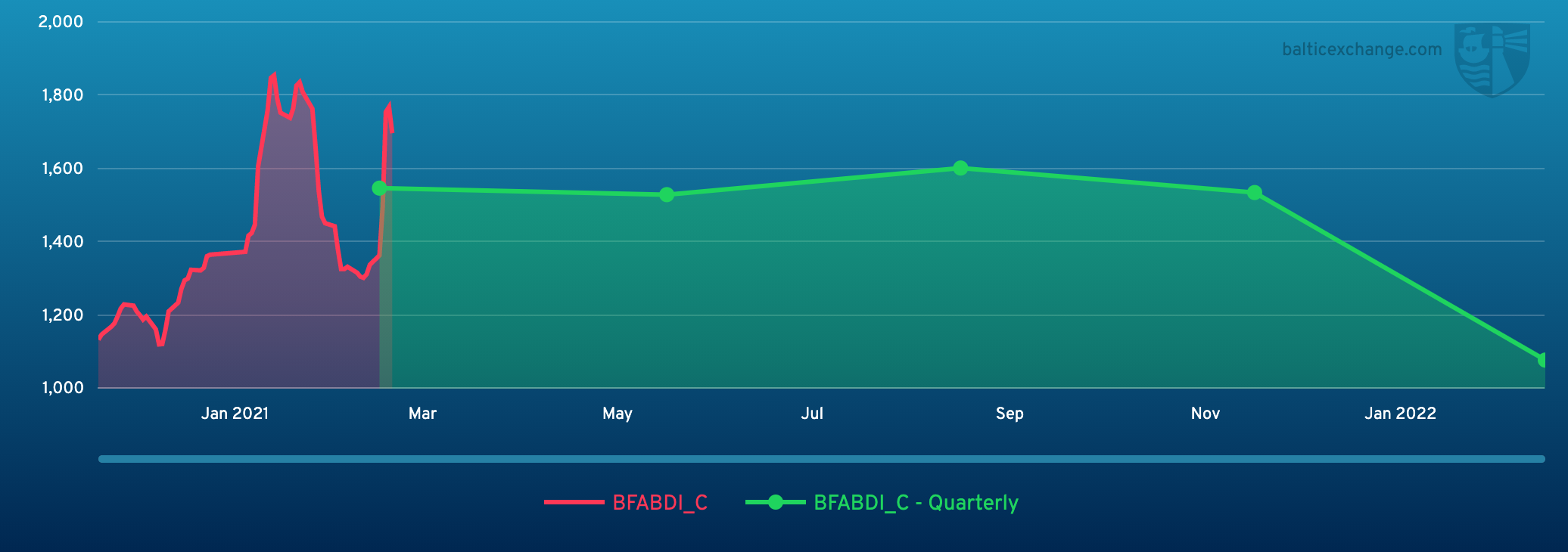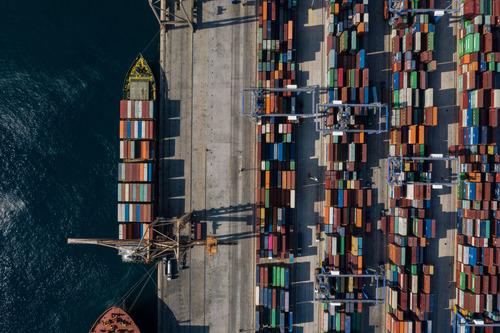BEIJING, Feb. 20 (Xinhua) -- The Baltic Exchange has published its weekly report of the dry and tanker markets for February 15-19, 2021 as below:
Capesize
As one of the more wild weeks in the first quarter for the Capesize comes to an end, the market feels more like it's in reprieve mood contemplating what comes next. From last Friday at $10,304, the Capesize 5TC reached a high on Wednesday of $15,856 before retreating to close the week out at $14,224. The Australia and Brazil to China routes battled it out for tonnage throughout the week as Owners swayed both directions. The west Australia to China C5 opened the week at $5.82, peaking at $8.40 before closing Friday at $7.05. Throughout the week the paper market was heard to be very active and while the Cape market charged, it was definitely not alone as smaller bulk carrier sizes were treading a similar route. The Panamax sector was arguably the star of the show giving Capes somewhat of a leg up with the smaller cargoes combining for Capesize business - a rarity indeed. While the Capesize market has closed down a little for the end of the week, calm seas are unlikely with so much whipsawing in recent days combined with returning Chinese New Year traders.
Panamax
It was the most vigorous week since 82,000dwt became the new Panamax benchmark vessel in January 2020, with activity on physical and derivatives. North Atlantic remained fairly firm with both P1A and P2A making significant rises in the first half of the week on the back of demand for Baltic cargoes and breaching INL. A Kamsarmax delivery in the Continent was fixed for a trip via US east coast to redeliver in Gibraltar at $26,250. Shorter coal trips via Indonesia were paying a premium over the demand from east coast South America. However, in the second half of the week, charterers also took a little pause after the gap was widened between their ideas versus owners. The period fixtures were active this week, ranging from a 82,000dwt fixing from east coast India for five to seven months at $15,250 to a 79,000dwt fixing from Xiamen for three to five months at $23,000. For an east coast South America run, the rate started from $17,000 on a 76,000dwt delivery west coast India and low $15,000 delivery China's Taiwan to $23,500 on an 82,000dwt delivery Indonesia and $22,000 delivery Singapore later of the week.
Ultramax/Supramax
Like the larger sizes, it was a very positive week with a shortage of prompt tonnage and strong sentiment. This led to the BSI gaining 296 points by week close. Period rates strengthened, a 63,000dwt open Indian ocean fixing in the low $20,000s for six to eight months. Rates within the Atlantic leapfrogged with 55-57,000dwt fixing rates in the upper teens delivery west Africa for round voyages via Brazil to Continent-Mediterranean, with better levels paid for north Brazil loading. From the US Gulf, Ultramax tonnage was seeing rates in the low $30,000's for fronthaul trips with some commenting that similar rates could be had for some trans-Atlantic runs as well. Despite the Chinese holiday, rates saw healthy jumps from Asia. Ultramax vessels seeing in excess of $15,000 for NoPac round voyages and further south a smaller 53,000dwt open Singapore fixing a trip via Indonesia to China in the low $15,000s. A 57,000dwt open Philippines fixed at $18,000 for trip to Vietnam. All eyes are focused on the upcoming week to see if the momentum continues.
Handysize
Similar to all other sizes, the question at the end of the week is what comes next or how far can this dramatic rise go? Compared with the same period last year, when the BHSI was published below 300 points and the time charter average ticked over $5,000, both are almost three times in value now. The surge started from east coast South America and the US Gulf, soon followed by the Continent and then Pacific later in the week. There was talk of a large-sized Handysize vessel open A-R-A-G fixed for a trip via the Baltic to US east coast at approximately $26,000, which might include breaching INL. A 35,000dwt open Brindisi was fixed for a trip via the Black Sea to Santos at $17,000, whilst in Asia a 34,000dwt open east coast India was fixed for a trip to the Mediterranean at $10,000.
VLCC
Another stagnant week in this market with Worldscale fixing rates improving by less than a point. In the Middle East region, 280,000mt to US Gulf via the Cape/Cape routing continues to be assessed at around WS18.5 level and rates for China are hovering around WS32.5/33 on the back of another week of minimal fixing. In the Atlantic, 260,000mt West Africa to China was rated half a point up from last week at a fraction above WS35. Meanwhile, a 270,000mt from US Gulf to China saw rates gain about $90k to $4.34m although overnight we have seen Exxon reported to have taken on subjects the Hercules I (2017 built & recently scrubber fitted) at $4.5m.
Suezmax
Black Sea/Med rates have improved 3.5 points to WS73/74 level, most likely on the back of a firming med Aframax market, while rates for 130,000mt Nigeria/UK-Continent showed a similar gain to around WS56/57. Basrah/Mediterranean remains at about WS18-19 basis 140,000mt.
Aframax
This week's boom sector in the West, due not least in part to poor weather. The Mediterranean market has been rampaging this week with 80,000mt Ceyhan/Lavera up 45 points to WS120 (basis a round voyage, about $16,800/day TCE). Rates in Northern Europe also firmed, albeit not by as much as the Mediterranean, with 80,000mt cross-North Sea leaping 15 points to WS97.5 level and 100,000mt Baltic/UK-Continent up 11 points to WS86/87. Across the Atlantic, rates have also significantly risen. Both the 70,000mt Caribbean/US Gulf and the 70,000mt US Gulf/UK Continent are now rated at WS109/110 level - rises of 19 and 32 points respectively.
Clean
It has been another uneventful week for LR tonnage where Middle East Gulf/Japan remained relatively static in the low WS60's. But by week-end it was closer to WS65, whilst LR1's rates were in the WS80/82.5 region. The conference rate of WS120 has been maintained for 35,000mt AG/East Africa. In the Continent/USAC MR market rates picked up a little, as the winter storms in the USA resulted in significantly increased demand. This resulted in a jump from WS125 at the start of the week to around WS160 level. There was even talk of a prompt requirement from Port Jerome being fixed at WS172.5. However, with a couple of requirements being withdrawn and some handy tonnage being taken, brokers feel rates may come under pressure and a cargo to West Africa drew a number of offers with Charterers said to have been countering at WS155. The backhaul MR trade from US Gulf to UK-Continent has been uninspiring and last seen fixed here was at WS65, representing a five-point drop over the week. The weakness in the US Gulf was evident in rates for Brazil which eased around four points to barely WS105 level. It was another positive week for handy Owners. Trading cross-Mediterranean, where rates gained 50 points to around WS210 region after peaking at WS 215 for East Med loading, and WS235 was said to have been paid loading from Black Sea.
Headquartered in London and a subsidiary of the Singapore Exchange (SGX), the Baltic Exchange publishes a range of indices and assessments which provide an accurate and independent benchmark of the cost of transporting commodities and goods by sea. These include the Baltic Dry Index (BDI), the dry bulk shipping industry's best known indicator. Published daily since 1985, this provides a snapshot of the daily spot market earnings of capesize, panamax and supramax vessel types on the world's key trading routes.

Chart shows Baltic Dry Index (BDI) during Feb.21, 2020 to Feb. 19, 2021

Baltic Forward Assessment for BDI
In March 2018 the BDI was re-weighted and is published using the following ratios of timecharter assessments: 40 percent capesize, 30 percent panamax and 30 percent supramax. The information is provided by a panel of international shipbrokers.
(Source: The Baltic Exchange, edited by Niu Huizhe with Xinhua Silk Road, niuhuizhe@xinhua.org)




 A single purchase
A single purchase









